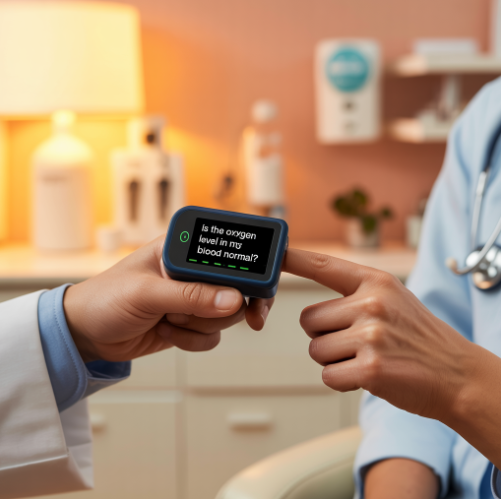Is the Oxygen Level in My Blood Normal?
A healthy blood oxygen saturation range is 95–100%, or 75–100 mm Hg. Hypoxemia, or low blood oxygen levels, may be something to be concerned about.
Blood oxygen levels may need to be monitored by people with specific medical
problems in order to assess if treatment is effective or needs to be modified. These
circumstances could consist of:
Chronic obstructive pulmonary disease (COPD)
Asthma
Cardiac disease
Heart disease
The pulse oximeter and arterial blood gas (ABG) is the two test types used to
measure blood oxygen levels. You can use a pulse oximeter in a doctor's office
or at home. ABG is a very accurate test, but it needs a blood sample drawn by a
medical specialist. To find out more about blood oxygen level measurements,
causes, and therapies, continue reading.
Knowing what your Blood Oxygen Level Indicates
Depending on the kind of test used to determine your blood oxygen levels, your
results can change. The SpO2 level, or percentage of saturated blood, is shown
by pulse oximeter readout. 95–100% is a normal, healthy reading. Your doctor
could advise getting an ABG if your SpO2 level is less than 92%.
Because it is noninvasive and yields fast results, a pulse oximeter is the most
widely used test type. When compared to ABG results, FDA-approved pulse
oximeters could have an error margin of two to three percent.
Although more invasive, this test is extremely accurate.
|
|
Arterial Blood Gas (ABG) |
Plus Oximeter |
|
Healthy Level |
75-100 mm Hg |
95-100% |
|
When To Get Medical Help |
Less than 74 mm Hg |
Less than 95% |
When should I seek medical attention? Fewer than 74 mm Hg; fewer than 95%
those with COPD or other lung conditions may fall outside of these ranges. Talk
to your doctor about your levels if you have a lung condition. They can assist
you in determining what constitutes a normal range for you.
Hypoxemia can occur when your blood oxygen level falls below 95%. The medical word for low blood oxygen levels is hypoxemia. This is frequently reason for worry because it can result in issues with the heart, kidneys, or brain.
You could feel symptoms such as:
Breathlessness
Chest discomfort
Gasping or coughing
Disorientation or confusion
Headache
Fast heartbeat
You may have alterations in your vision and cognitive function if your blood
oxygen level drops below 80–85%.
You run the chance of experiencing cyanosis symptoms at 67%. A blue staining of
your skin, mucous membranes, and nail beds is the telltale indication of this.
Additionally, respiratory failure brought on by cyanosis might be fatal. As soon as possible, seek medical assistance if you are exhibiting symptoms.
It's critical to understand your baseline oxygen saturation, particularly if
you suffer from a long-term lung disease. You can ask your doctor for advice on
what range of oxygen levels is suitable for you.
Hypoxemia can be brought on by certain medical diseases that impair lung
function. Among them are:
COPD, which includes emphysema and chronic bronchitis
Anemia
Congenital cardiac problems
Asthma
Collapsed lung
Pneumonia
Heart disease
Pulmonary embolism
Acute respiratory distress syndrome
In addition to blood illnesses, circulatory system issues can also hinder your
blood's ability to carry oxygen throughout your body. There are five categories
under which these illnesses and ailments might drop your blood oxygen levels:
Mismatch between ventilation and perfusion (V/Q)
Shunt
Impaired diffusion
Hypoventilation
Low ambient oxygen, which usually happens at high elevations
Raising the Level of Blood Oxygen
At-home Cures
You may naturally raise your blood oxygen levels at home in a number of ways.
Pursed lip breathing
Belly breathing
Going for walks outside
Opening your house to fresh air
Keeping houseplants
Giving up smoking or avoiding secondhand smoke
Getting regular exercise
Eating a well-balanced diet
Saturation of Oxygen
You could require more oxygen if your blood oxygen level is too low in order to
raise your oxygen saturation.
Since home
supplemental oxygen is a drug, a prescription from a doctor is required. It's
critical to heed their recommendations on the usage of home oxygen in order to
prevent difficulties.
Frequently
Requested Inquiries
Is
92% of oxygen a healthy amount?
A healthy blood oxygen level is
between 95% and 100% in most persons. Anything that is less than 95% is
regarded as low and could lead to hypoxemia.
It is stated that some medical
diseases, including COPD, may require a different blood oxygen level to be
maintained. Consult a physician to ascertain the appropriate or feasible
threshold for you.
What
level of oxygen should I be worried about?
If your blood oxygen saturation is less than 95%, you may be at risk for hypoxemia. Low blood oxygen levels can cause the following symptoms:
Shortness of breath
Chest pain
Coughing or wheezing
Confusion
Headache
Rapid heartbeat
A blue staining of your skin, mucous membranes, and nail beds.
Seek quick medical assistance if any of these symptoms apply to you.
A blood oxygen saturation of less than 95% is deemed poor. It is possible for a pulse oximeter to have an error margin of 2-3%. ABG testing could offer a more precise reading if your blood oxygen level is a source of concern.
Conclusion
The blood oxygen level must be kept between 75-100 mm Hg, or 95 and 100%, for the kidneys, heart, and brain to remain healthy. The majority of people don't require routine blood oxygen level monitoring.
Nonetheless, pulse oximetry is a rapid and noninvasive way to measure your oxygen levels if you have a medical condition that could result in low oxygen conditions.
For more Interesting Articles click the Link: Health Care







Comments
Post a Comment